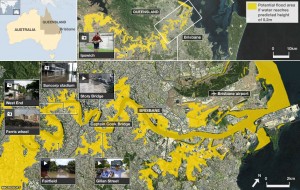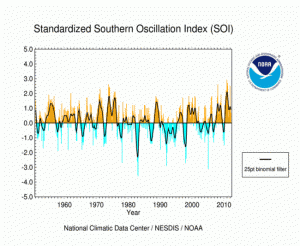Just over four years after my first visit to Australia (From drought to flood down under: Part I), the tides have turned and the country has gone from experiencing the driest decade on record to having the wettest two-year period on record in 2010-2011. These recent rains have been both a blessing and a curse. The good news is that they helped the region of southeastern Australia start to recover from the long drought (see Figure 1). The bad news is that the rains came on heavy and strong. In January 2011, devastating floods occurred across southeastern Queensland, including in its capital city of Brisbane (Figure 2). Flash floods even wreaked havoc in communities like Toowoomba and the Lockyer Valley. Then in February this year, flooding returned to southeastern Queensland as well as other parts of Australia, resulting in more devastation.

Figure 1. Cumulative rainfall anomalies (in mm) for southeastern Australia from 1997 to December 2011. Individual monthly anomalies are shown by the bars at the top of the figure. (From BOM)

Figure 2. Map of potentially flooded areas in southeast Queensland and the capital city of Brisbane (From BBC)
What a change for this region to have gone from being so close to running out of freshwater to being inundated with it! What is happening?
Well, this region has a very strong link to the El Niño Southern Oscillation (ENSO). When ENSO is in an El Niño phase, the region experiences drier conditions than when ENSO is in the La Niña phase. La Niña brings warmer sea surface temperatures and associated enhanced convection to the eastern Australia coastal region, thereby inducing wetter weather. The ENSO phases are measured by the Southern Oscillation Index (SOI), and it just so happens that the past two years have had record positive SOI (indicative of the La Niña phase) and record sea surface temperatures (Figure 3). In fact, the previously notable record flood in Brisbane occurred in 1974, which also happened to be another very positive phase in the SOI.

Figure 3. Southern Oscillation Index (SOI) for the period of record. Positive values indicate La Niña episodes. (From NCDC)
While it seems extreme, dramatic shifts from droughts to floods are actually part of the foundation of this country, as rhythmically described by Dorothea Mackellar in her 1908 poem “My Country” (Click here for full poem):
I love a sunburnt country,
A land of sweeping plains,
Of ragged mountain ranges,
Of droughts and flooding rains.
I love her far horizons,
I love her jewel-sea,
Her beauty and her terror -
The wide brown land for me!
However, with population increasing, more water is needed for human consumption, crops, and industry, while too much water damages the growing communities and vital croplands. Managing these extremes is not an easy task, but is a necessity to continue building the Australian way of life.
Suggested activity: Look for cycles in precipitation patterns from one year to next and over several decades with long-term precipitation data and compare these trends with climate indices, such as the SOI to see if there are any ties to ENSO in your region.
-Sarah Tessendorf

Is this SOI thing can be practiced in Indonesia?
LaPecelle.com – there is a very strong relationship between weather in Indonesia and ENSO. You can definitely perform the suggested activity there!
More people need more drinking water, but too much can damage the growing community. Well it is a death circle where we have to find a way out of it. Not sure how we can manage it, but we need to find a way, we just need to find a way